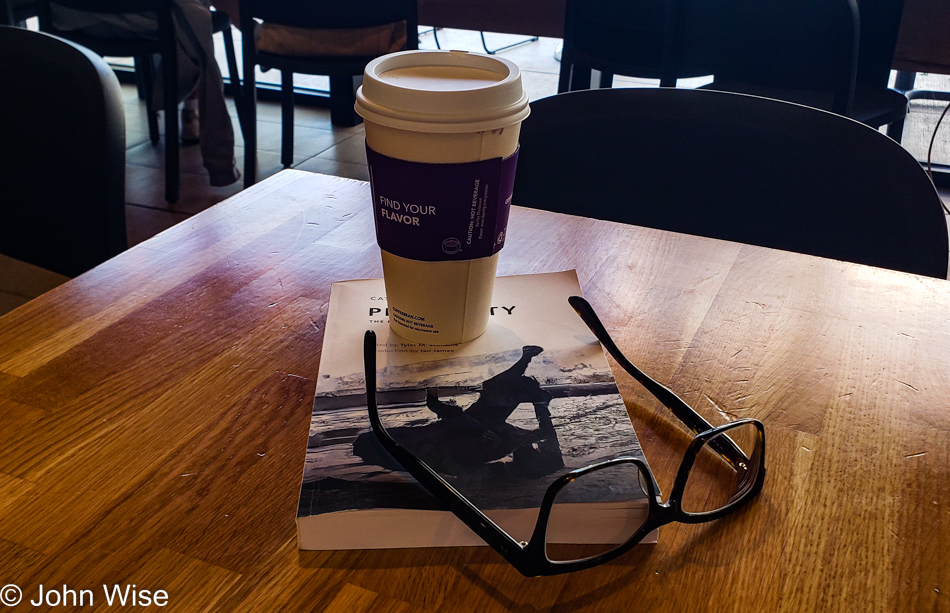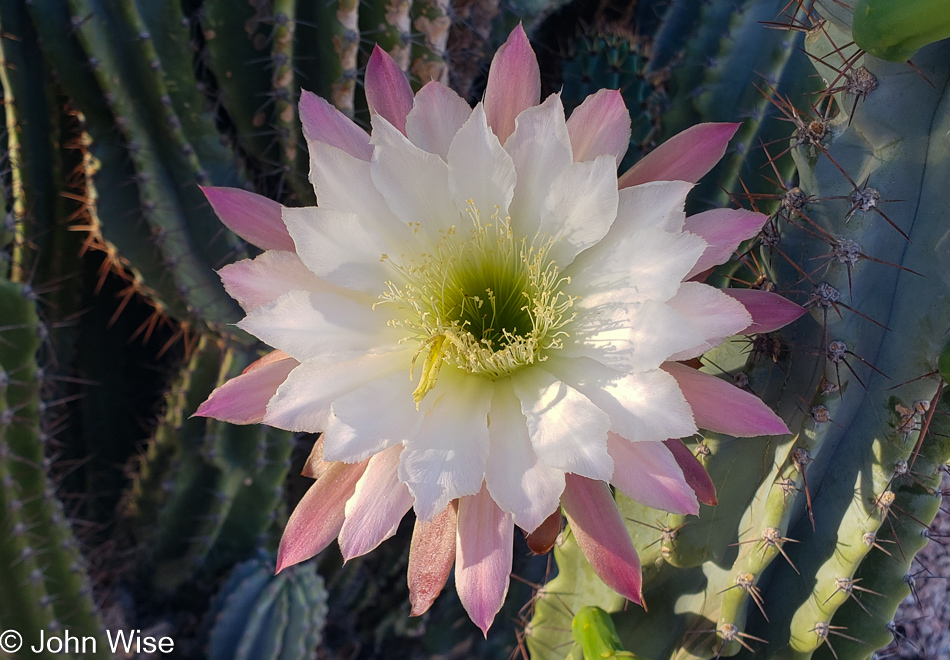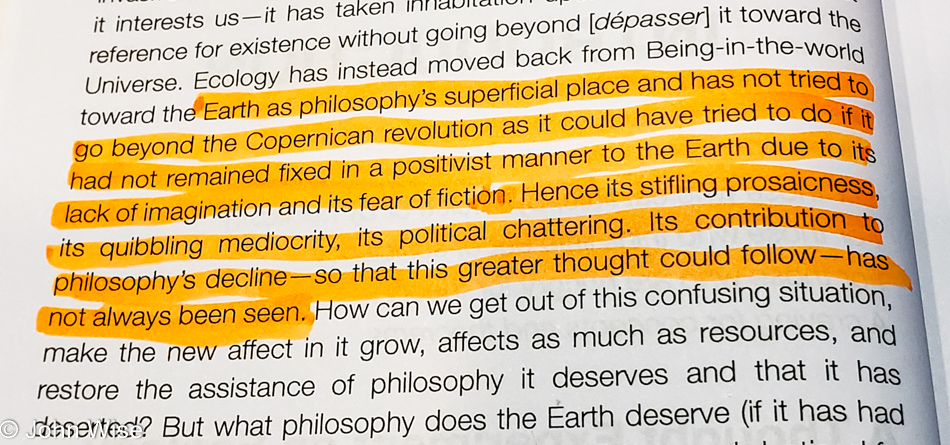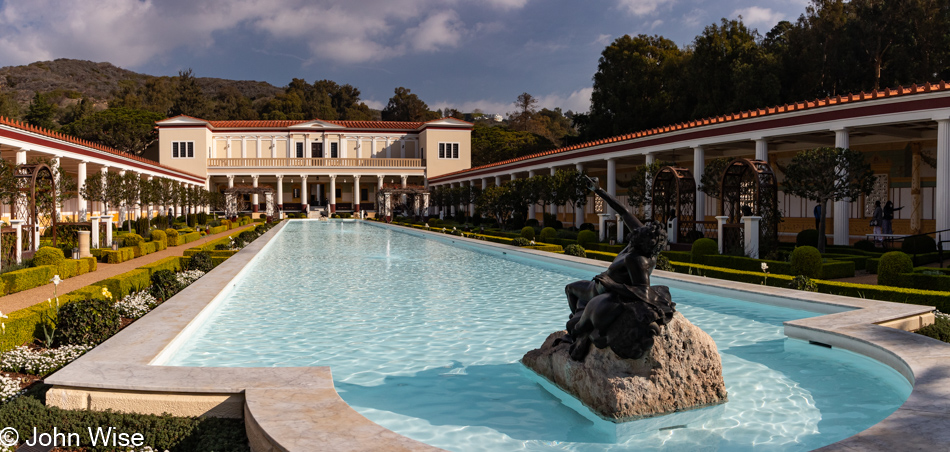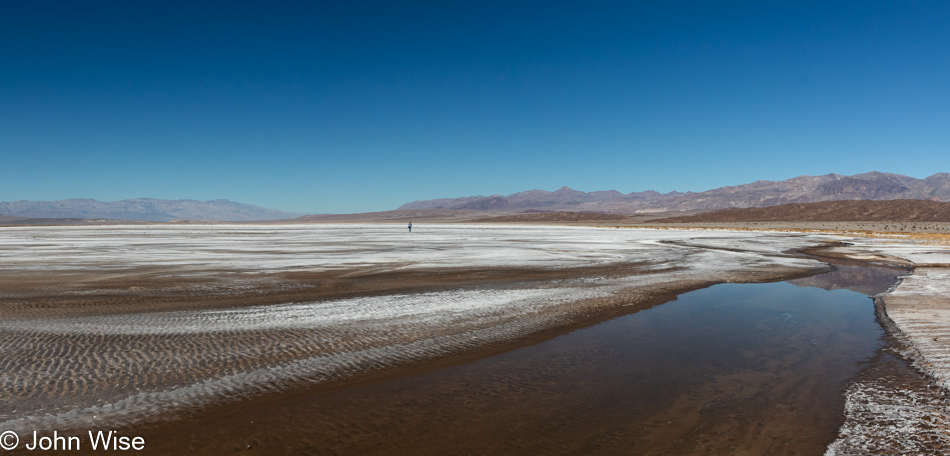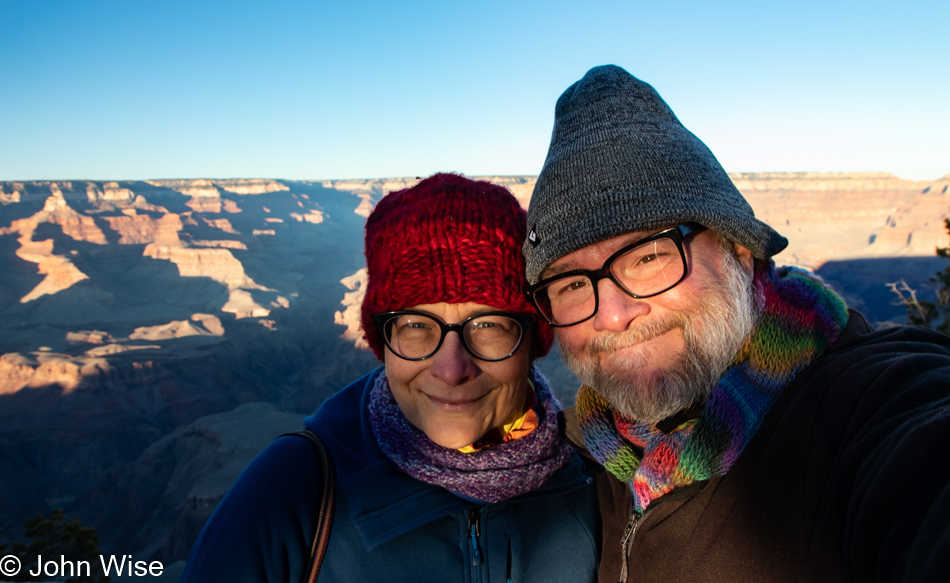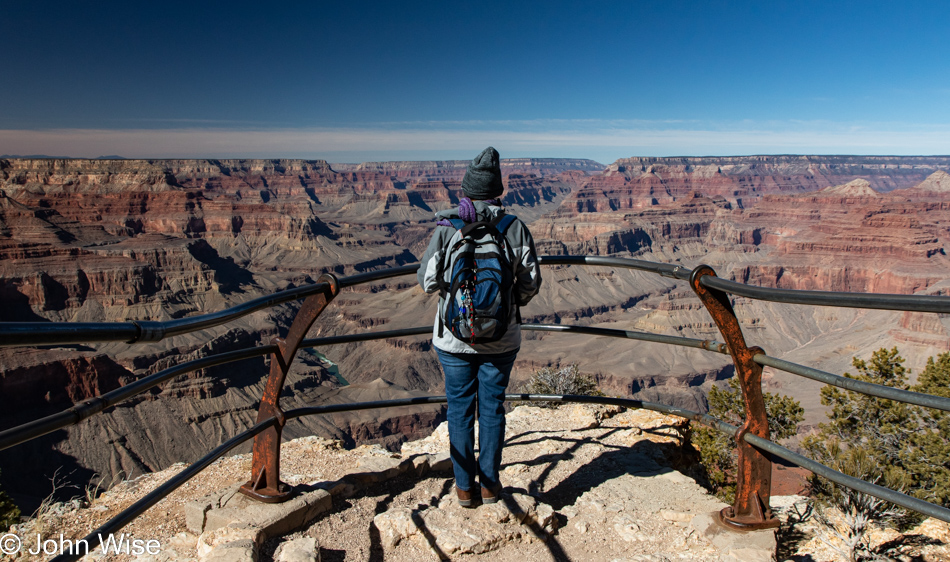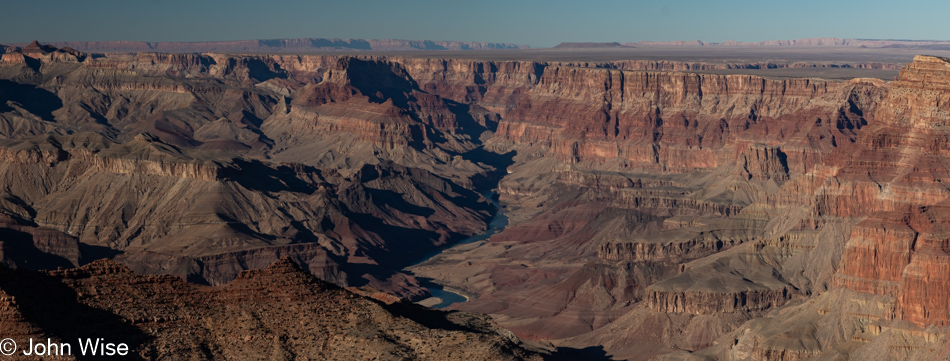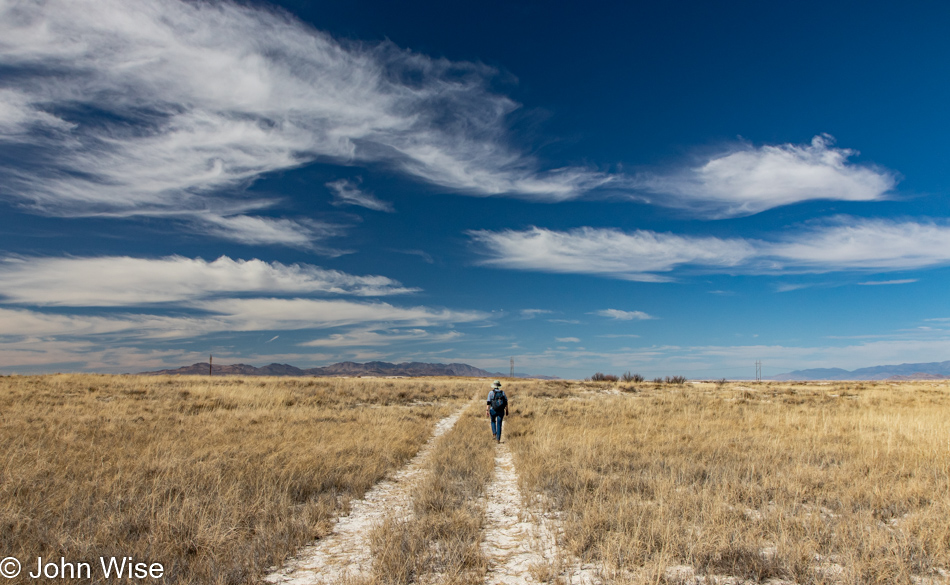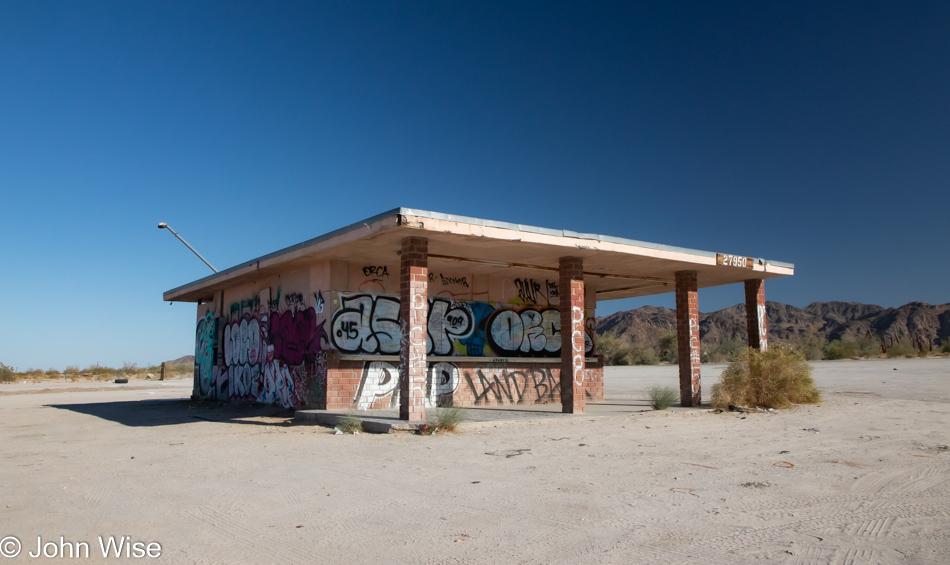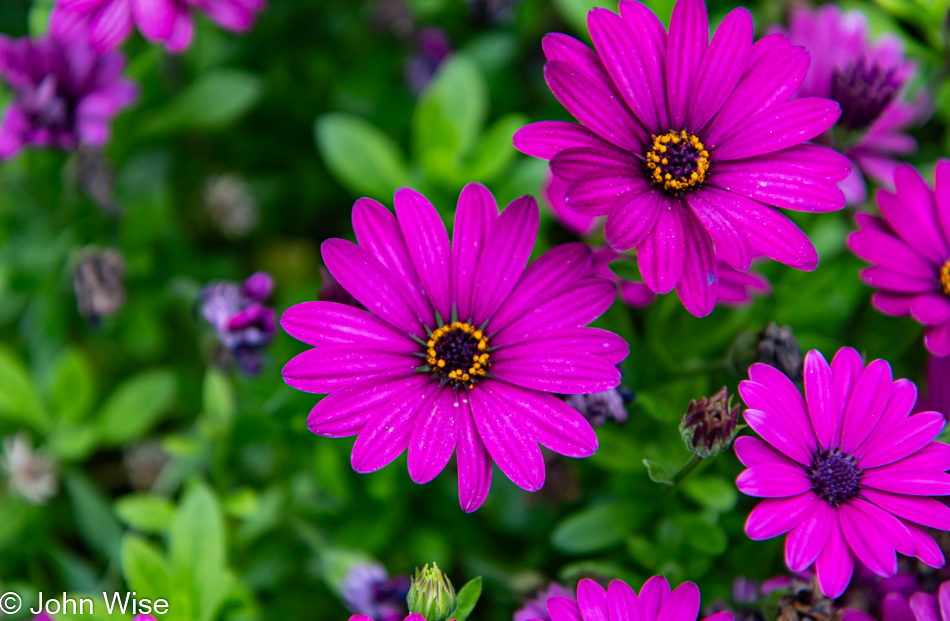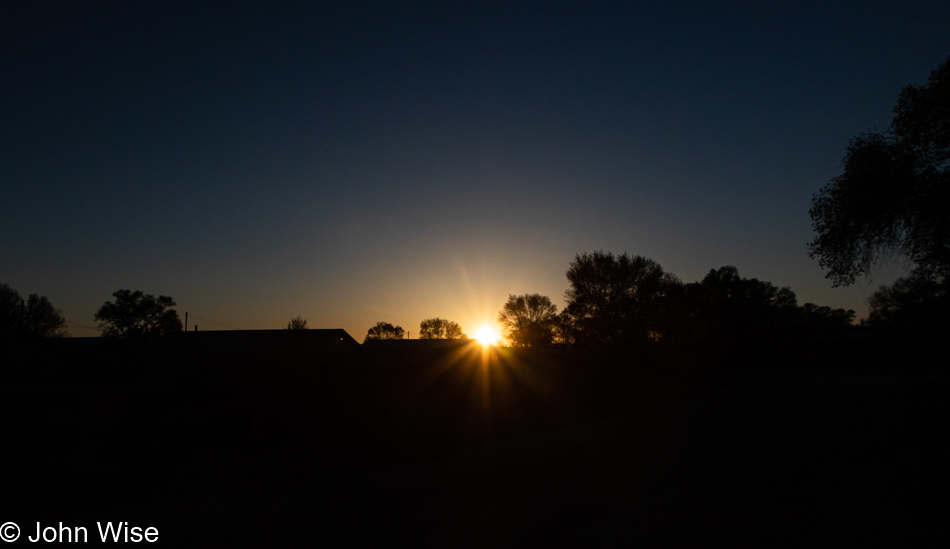
Out with the rising sun, barking dogs, hornos (beehive-shaped adobe ovens pictured below), and a man named Elroy singing us a song dedicated to John and Caroline while accompanying himself on the air guitar; this was a first. That’s how our perfect Saturday began in the Native American village of Zuni, New Mexico.

We are staying at the one and only place for lodging in this small town of approximately 6,000 people, the Inn at Halona. Further north up on Interstate 40, traveling from Gallup, Grants, and Albuquerque to points further east, the towns along the freeway are noisy, generic, and sad. Some might argue that Zuni, a bit south of all that, is sad, too, but they’d be wrong. It’s simply reflecting with brutal honesty how colonizers disadvantaged a people for which there was little room in the expanse of white America. In this sense, Zuni is much like Window Rock, Arizona, or Oglala, South Dakota, but the locals have never been less than stellar with us. It’s strange how those on the margin are often some of the most generous people we meet during our travels.
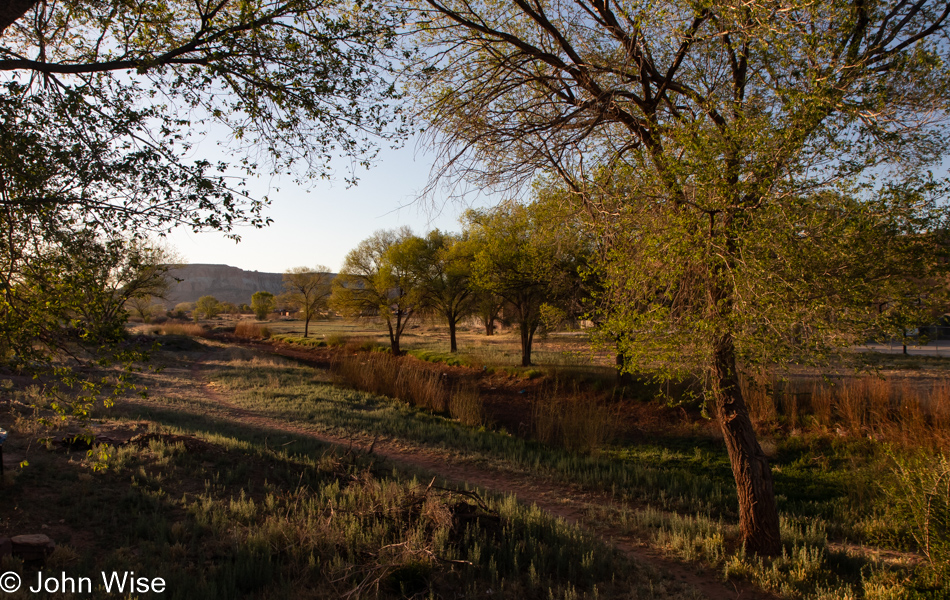
Last night, during a late check-in, we learned (maybe we were reminded, I’m not sure) that breakfast was included. Since the Halona Inn is a bed and breakfast, it should have been apparent that it would include the first meal of our day. We dined on a sumptuous affair crowned by blue corn pancakes and served promptly at 7:00. Trey is our server and cook, and I’d likely be correct in saying that she’s A’shiwi (the Spanish named the people of this region Zuni). Her enthusiasm and friendliness really contributed to breakfast being better than it might have otherwise been.
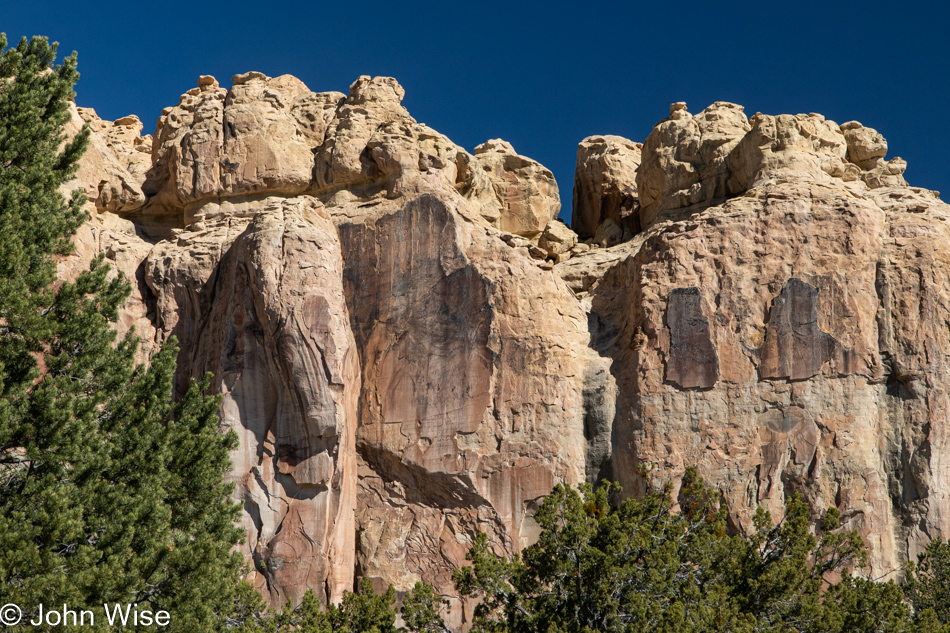
There was some hesitation in eating breakfast at the Inn as we’d brought our own to allow us to get out on the trail at daybreak, but thinking twice about it, a hot breakfast here on the Zuni reservation sounded enticing. Good thing it worked out this way and that we were willing to linger a bit longer on our way to El Morro National Monument as it turned out that the park doesn’t open until 9:00 anyway. We waited less than 5 minutes before the automatic gate swung open, allowing us to make our way to the visitor center and the trailhead.
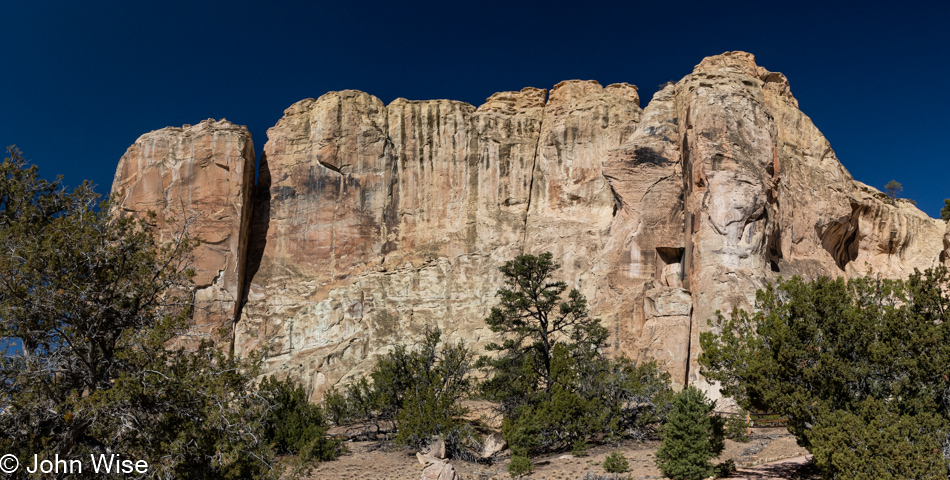
There are three possible paths from here for us to take; the first goes to the right to Inscription Rock and Mesa Top Trail Loop further on. We can go left directly to the Mesa Top Trail and the Pueblo ruin we’ll also reach if we take a right. Our third choice is to turn around and leave; well, that’s hardly a viable choice after putting ourselves out here just for this anticipated hiking adventure.

We opted to go to the right to match our political affiliation (NOT), and the first unexpected sight is found here in this alcove. Signs of waterfalls abound. Obviously, with the cloudless blue skies that are accompanying our day, there’s not a drop of moisture that will flow from those chutes carved into the sandstone. But just below…
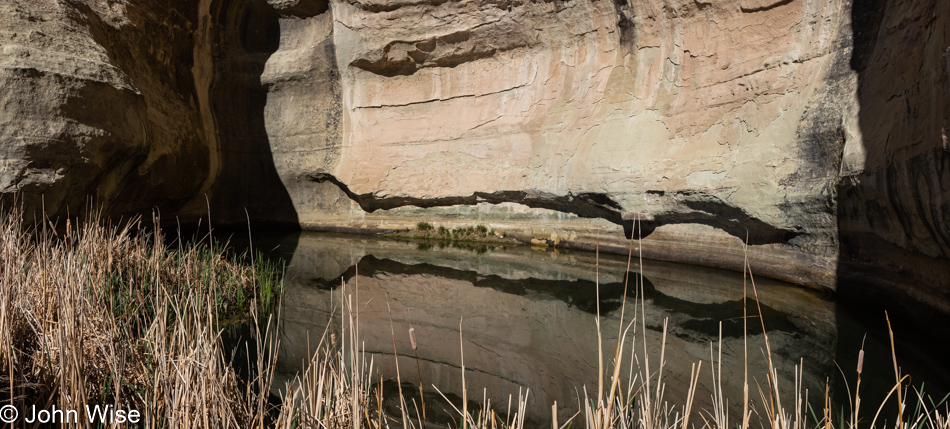
…is this pool with a depth of about 12 feet. This reliable source of water brought people into the area for centuries.
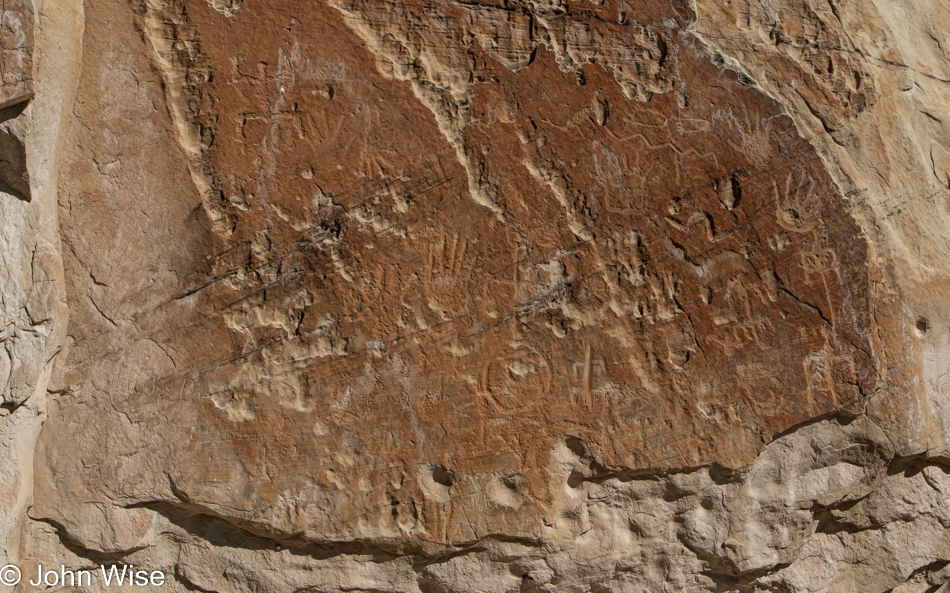
Obviously, Native Americans were the first in the area centuries before anyone of European descent arrived on the scene.

The Ancestral Pueblo Indians who lived on the cliffs above were present from around 1275 to 1350 AD, while the Zuni/A’shiwi have been living in the area for about 1300 years.
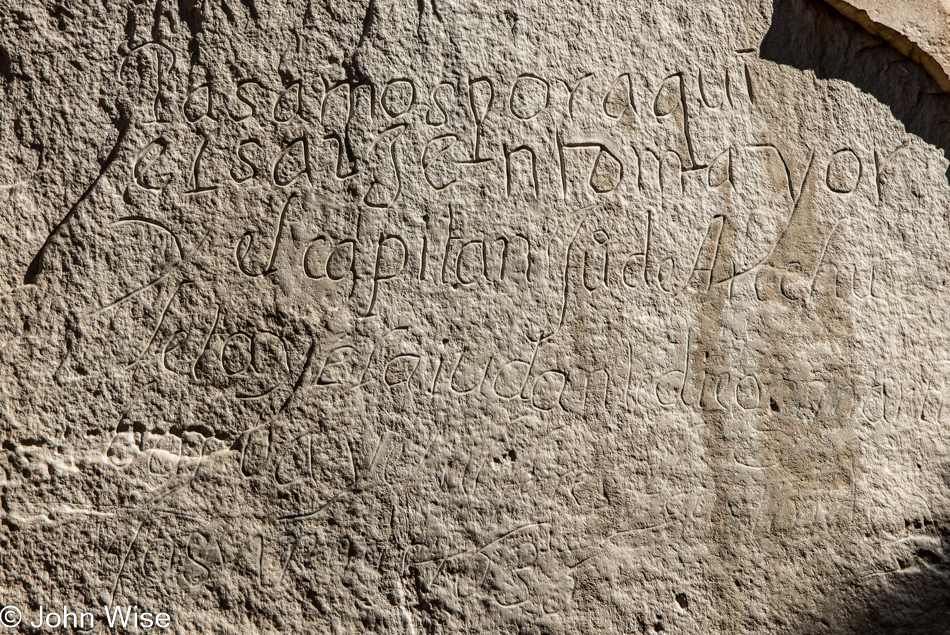
Then, back in about 1540, Francisco Vázquez de Coronado first encountered the Zuni. Whether he made it to this watering hole remains unknown, but there you have it, a European in the Southwest of the North American continent. Sixty-five years later, Juan de Oñate passed through here, leaving his autograph on Inscription Rock. This photo is not of that precise panel but is a fair enough representation of the style of messages left when Spaniards were passing through. Juan de Oñate came to New Mexico in 1598 and became a villain in the eyes of the Puebloan Indians in the area when he ordered the slaughter of 500 people in retribution for the killing of a dozen conquistadors in 1599.
The inscription pictured above says, “We passed by here, the Sergeant Major and Captain Juan de Archuleta and Adjutant Diego Martin Barba and Ensign Agustin de Ynojos. The year of 1636”

Skip this part of my story if you want to avoid controversial politics about which I’m opinionated but ofwhich I am no expert. A segment of America is raging at the moment of this writing about Critical Race Theory (CRT) and the Great Replacement bizarro idea. Critical Race Theory opponents are afraid that white children might be made responsible for answering to the misdeeds of their forefathers, while the Great Replacement asserts that minorities are out to replace white people. I’m of the belief that the white Christian hegemonistic bias that has been at work for far too long upon these shores is afraid to let go. Where once we railed against primitive, archaic people who originally populated this country, we ourselves are now the primitive, archaic people afraid of change.
Although white Europeans from Spain arrived in the lands that would become the western United States 80 years before the pilgrims landed and Ponce de Leon visited what would become Florida in 1513, I was taught that American history really begins at Jamestown in 1607 and at Plymouth Rock in late 1620 and then again in 1776 while the interloping Spaniards were of no particular consequence as they were not from North European stock anyway which is where the good god-fearing Christians come from. Was the Catholicism of the Spaniards part of the problem and the reason why there was so much controversy around John F. Kennedy becoming president as a Catholic? Our fundamentalist roots that took hold in the northeast feel like a boat anchor holding America back as we’ve sacrificed education (maybe a poor example, but look at the first carving made by an American citizen at this monument that includes a typo, insciptions) in order to enforce a kind of intellectual violence aimed at maintaining conformity and fear of the future. Our common knowledge is no longer commensurate with the rigor required at this time in history.
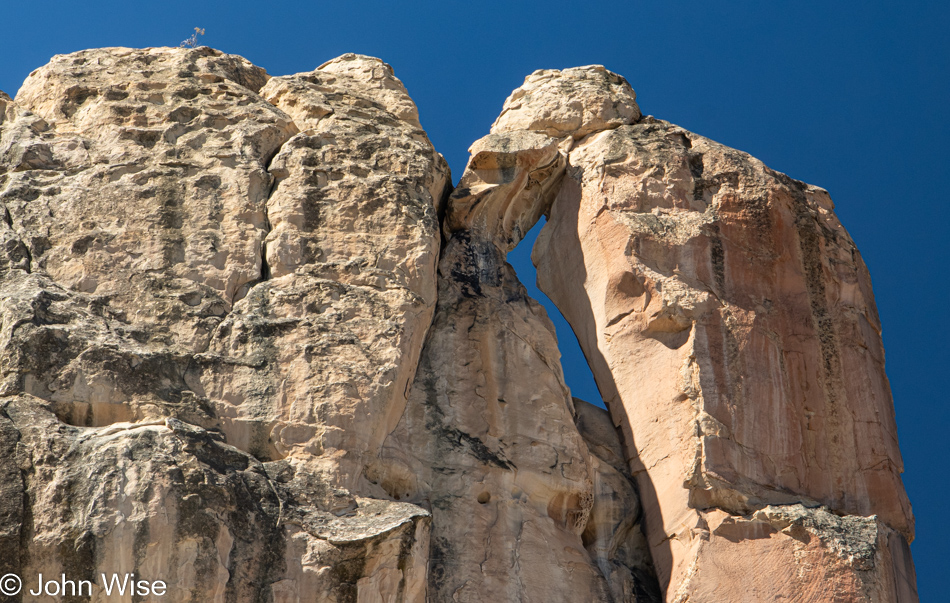
Someday, this massive tottering chunk of sandstone will collapse, and the monument at El Morro will be changed. With the passage of time, the inscriptions carved on these walls, noting who passed through here starting before 1605 and continuing until the early 20th century when this area was designated a national monument, will all fade and disappear. But none of this will change the fact that this was a part of our cultural history and remains part of the permanence of the earth. In my brief moment of being human, I have the opportunity to experience these things the way they are, understand how they were, and hope to leave it all in at least the same condition with which I was fortunate enough to have been presented. Maybe that’s the best we can do with nature and history, but regarding our intellectual and cultural capacity, we should always be striving to build personal monuments that can best weather the elements of reflection and accountability.
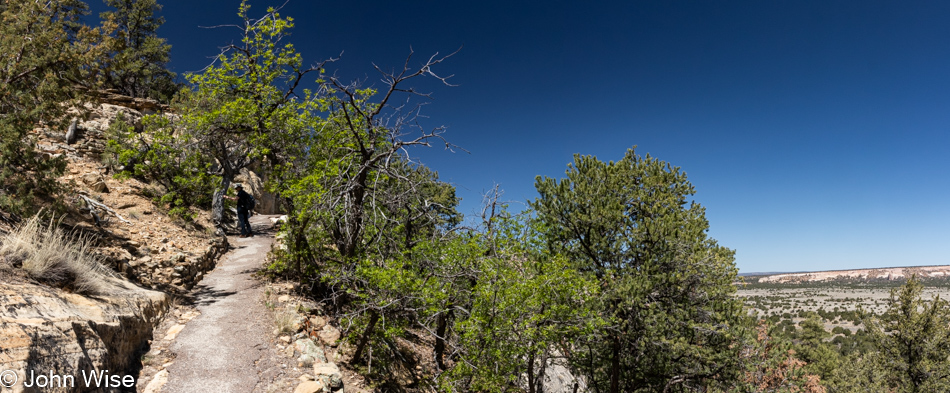
We slog up the switchbacks as we need to gain elevation if we are to capture what lies above in the unknown heavens that remain out of sight.

But don’t forget to get lost in the enchanting details that might otherwise remain unseen should your desire to reach the destination have you racing over the trail. This applies not only to the day or hour but to the entirety of your life.
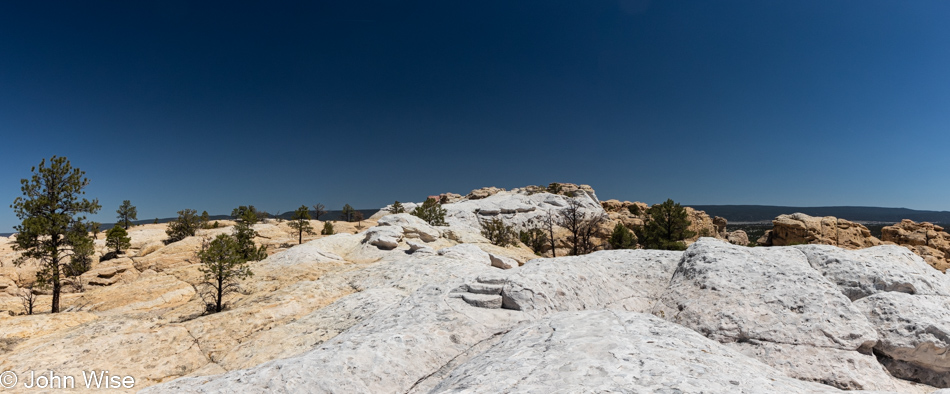
So, there you are, traveling with confidence and curiosity until you encounter the BLOCK. Fear drills into you, and uncertainty grips your strength as the ability to carry on is no longer certain. The good intentions begin to crumble. That’s just what happens to me every time I reach that place in my path where my personal weakness rears its ugly head, screaming at me to start trembling. I oblige as I consider the abyss I’ll certainly stumble into because the sides of the path ahead that would otherwise support me fall abruptly into apparent nothingness. This is my fear of heights, where an irrational mind is making decisions that would stop me in my tracks. It does happen that I am forced to give in to that crippling effect, but today won’t be that time.

Before we ever got out here, I examined the trail from across the ridge using our binoculars. I watched a family of five traverse the terrifying heights of near-certain death with their 5, 7, and 8-year-old (my estimation) children seemingly oblivious of their own mortality; oh yeah, they are at that age they are unaware of such things. I had to dig deep to muster the strength of determination if we were to see that pueblo ruin on the other side with our own eyes. I just had to share this experience with Caroline instead of denying the two of us the reward of accomplishing what we set out to do. This idea of never giving up sure comes at a cost; in this instance, it’s called panic.

If you look at the photos I’m sharing here on the razor’s edge and wonder what the big deal is, consider that I’m only able to stop and snap an image where I’m absolutely certain about my footing. Ambiguity about my wavering center of gravity requires I focus on the most serious of tasks, where are my safe places, and don’t fixate on the potential of my feet not performing as they have for more than 55 years. This photo of the stairs was one such moment where I still had a split second to grab the photo and capture this brilliant carving showing us the way down. The place I was standing was not ideal, but I was able to bring up the camera just long enough to snap this image, not two shots, just this one, of which I was uncertain if I’d framed it decently.

Breathe, find the center, look around, and calm down. There’s immense beauty out here and profound accomplishment when each step demands a level of commitment that, from moment to moment, feels impossible. I cannot photograph the places that offer the greatest accomplishment, that of me overcoming me, but when I get to my safe place, I can stop to revel in what I just did and the wonderful new sights and vistas that have opened up for me having gone through the impossible. Writing when I’m less than inspired is part of this design to go further. I don’t always have inspired words; some could argue that I never have but I do have the wherewithal to not give up or take an alternative easy path. As much as I loathe the difficulties, I’m aware that I’m able, with enough effort, to make the kinds of strides that, in retrospect, gave me more life than I would have otherwise found in front of a TV, playing a video game, or tossing back a drink at the sports bar. That’s right; I’m here on the Headlands Trail at El Morro, finding out more about myself, love, aesthetics, beauty, strength, and the universe just by looking at the patterns found in a random spot of sandstone.
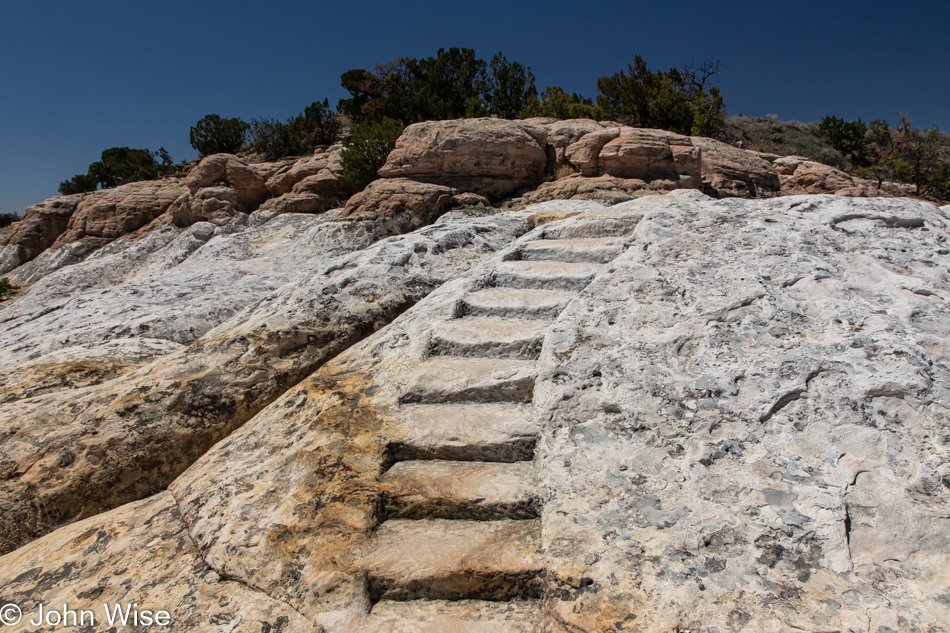
This is how we ascend to heights above our meager beginnings. From deep below, where we dwell in the murky world of our naivete and ignorance, we watch the shadows of others creating our false reality while, on rare occasions, the individual arrives on the scene who appears to have been born with an impatience to see, know, and do more. Then the question arises once you’ve climbed those stairs: do you own a vocabulary and evolving knowledge of the world to find sense and meaning in that obscure realm of the unknown you’ve not experienced prior to your arrival?
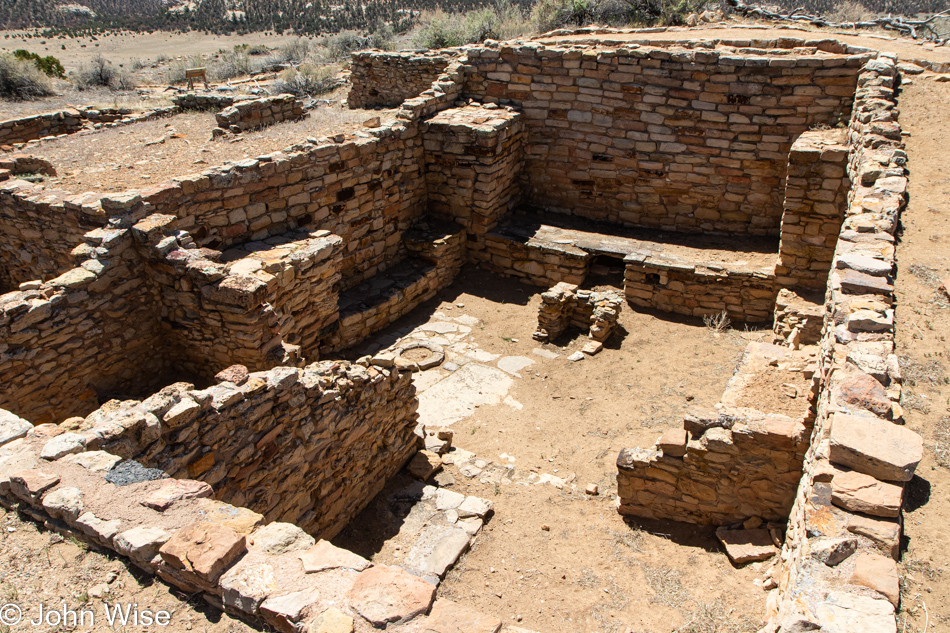
Look for luxury hotels in New York City, and you’ll easily find a dozen that will want more than $1000 a night; if you are seriously wealthy, you can part with as much as $75,000 per evening. Should you want to spend a weekend between a pueblo and a kiva, well, that’s priceless, priceless because it’s not available. There’s no such accommodation or situation that allows a visitor to spend any amount of money or time that brings them into the history, ritual, ceremony, or sharing of the sacred with the Puebloan people of the Southwest. For me, and if I can speak for my significant other, the sacred, be it sea, mountain, creature, desert, sunrise or sunset, cathedral, laughter, or the imagined world of what might occur within the kiva, these are the most profound luxuries that can only be experienced with the desire to travel further within ourselves.
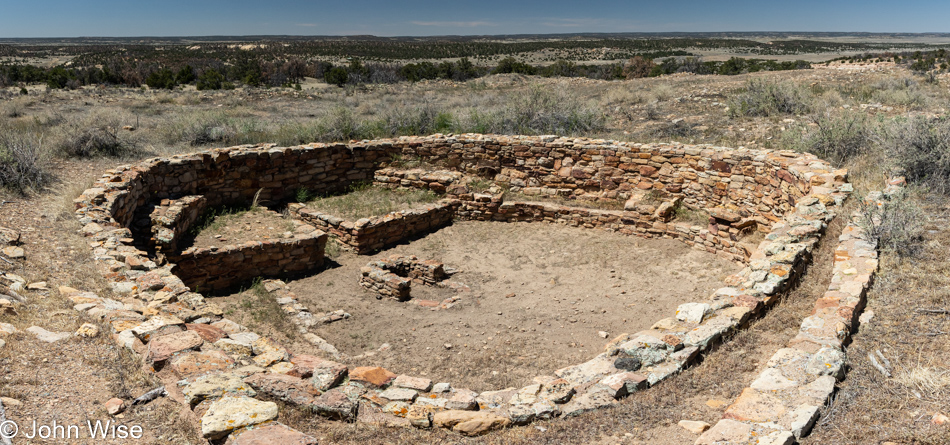
Though I’ve written more than a few times about kivas, I should consider that not everyone knows what they are as they encounter one of my posts. A kiva is a subterranean room, as pictured here and above, that at one time had a roof over it. These rooms were used for the rites of the Kachina and for political meetings. Among the Puebloans of today, kivas are still in use, but there is no invitation for outsiders to witness the proceedings due to our white-dominant culture having never been able to demonstrate respect for the practices of a people long considered not only primitive but subhuman, too. As a white man, I have no possible ability to conceive of what it’s like to be a person of color who’s been marginalized as a type of animal any more than I can understand what it is to be a woman, a fish, or a grain of sand.
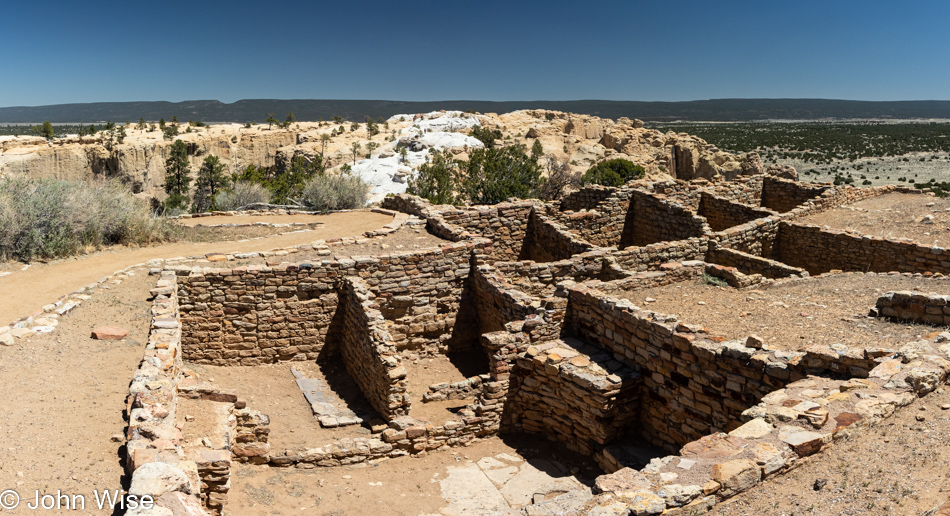
We’ve been making movies for more than 100 years, and while we’ve explored themes of aliens, monsters, outer space, the bottom of the sea, all types of realms out of fantasy, heroes, love, tragedy, war, cooking, dancing, and most anything else imaginable out of the more than 250,000 films ever made but there are very few that portray Native Americans in a realistic light. What was life like for the Ancestral Pueblo Indians? What did the area around Phoenix, Arizona, look like 1500 years ago when the Hohokam Indians built irrigation canals, farmed, and possibly visited Chaco Canyon over in New Mexico to trade with other indigenous people coming up from Central America? Sadly, my head is full of images of Indians on horses yelping while shooting arrows at cowboys, which always won when it comes to movies.

Now, just because the surface of things might be blemished by events that occurred deep in history, that doesn’t make us accountable for the flow of nature and how the world was evolving. Maybe what affected the variations that occurred in this sandstone were anomalies, and for some viewers of these artifacts, the uniformity of what their expectations informed them to appreciate is not being met here, but for others, this is a mark of perfection. What I mean to say is that ugly things certainly happened in our recent histories, but that doesn’t imply we’ll be perpetuating those poor behaviors; if we are, that’s a different matter. If we fail to address those who would bring intentional harm to people, places, and things that we should know better through reasoning, then our complicity in inflicting damage is an issue we must face and suffer the consequences of our own gross stupidity.
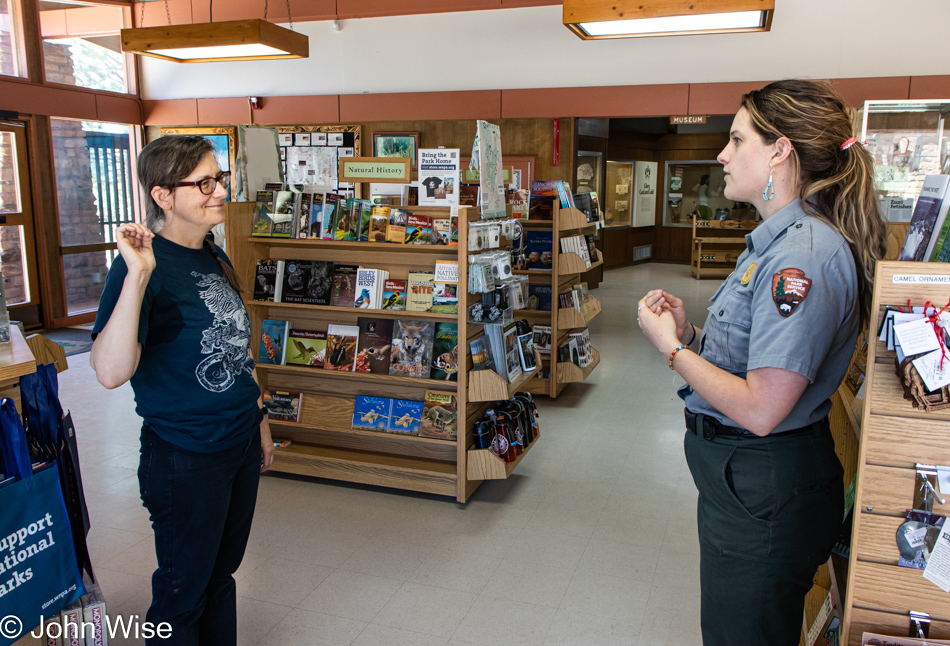
On the other hand, we can all quite easily celebrate the potential good within us when we slow down, take the time to get out of our routine, and maybe even do something that’s not altogether easy. From creating a grueling travel itinerary that promises to bring us to difficult junctures to those delightful moments when, after completing a junior ranger booklet, Caroline is awarded a badge that affirms she’s learned something more about the place we just invested so much in being at.

Time for a pause in the philosophy of participation and awareness; our stomachs needed to take the stage. Our expectations were low out here in Ramah, New Mexico, population 505; how good might a meal be in a town this small? Off the chart is the answer. The Ancient Way Cafe served us Reuben and BBQ brisket sandwiches that were nothing less than terrific; we skipped the potato chips, opting for a salad, and then, against our better judgment, we considered dessert. Really, nothing, in particular spoke to us, but a sweet sounded nice after our morning hike; plus, we are on vacation. With serious reluctance, we agreed on their apple pie ala mode but not just any apple pie but New Mexico style, meaning it came with pine nuts and green chili. No way, fresh apples, spicy chilies, not a lot of sugar, and an awesome crust. This required a couple of cups of coffee so we could kick back and enjoy this unexpected luxury. There is no doubt in our minds that this will be the best pie we have this year as it’s easily the best pie we’ve had in years.
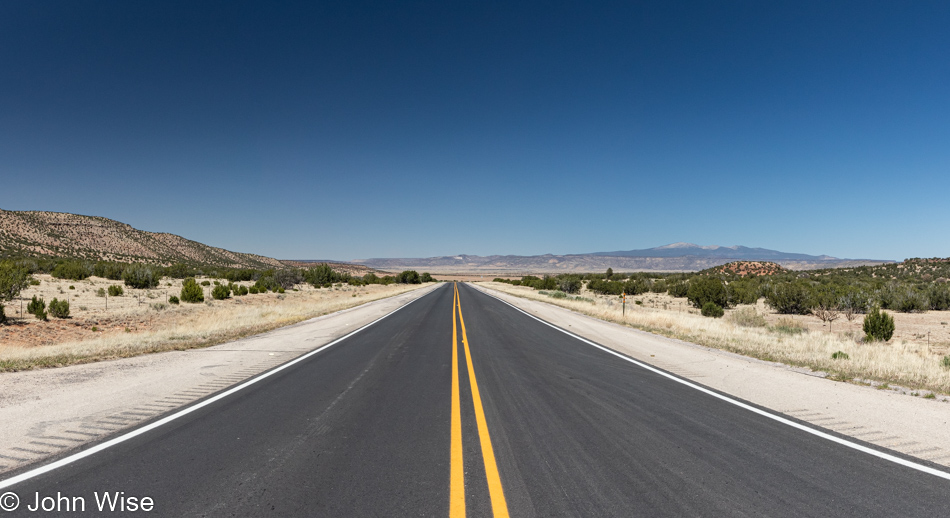
A perfect start to the morning, a perfect hike, perfect weather, and a perfect lunch all lend appreciation to our basking in the incredible where the horizon only holds more promise of great things. Sure, we could choose to see the cost of gasoline, lodging, and food as being impediments to enjoying these moments, but those are small consequences of using our time to find something more meaningful within ourselves that also works to further cement the intense relationship we share.
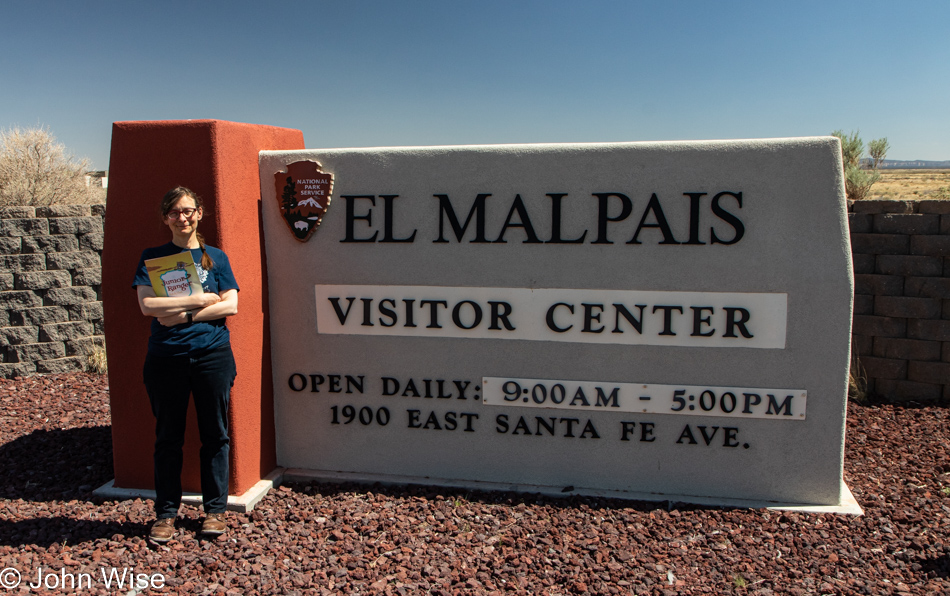
We jump-started Sunday by making the nearly hour-long drive to Grants, New Mexico up on Interstate 40 to dip into the El Malpais National Monument Visitor Center. By collecting the junior ranger booklet today, we’d be able to drop it off in the morning tomorrow to avoid backtracking up north instead of starting our trek home to the southwest. It’s not that we’d be in a hurry to rush home come Sunday, but by being able to retain the 90 minutes we might lose by needing to return to Grants, we’d have more opportunity to linger in the areas we might find attractive. Regarding this park and how to pronounce its name, we just learned this today: the park service says it is spoken this way: ehl MAHL-pye-EES.

Interstate 40 was a culture killer. The small businesses that once lined the legendary Route 66 have been devastated. Driving through Grants is a great example of what is lost when progress demands that speed and efficiency rule the day, which, to be fair, should be expected when projections of traffic would overwhelm the previous roadway. Without economic assistance after the interstate came in, many small businesses shut down, and their properties were left to rot as sad reminders of a romantic age following World War II, when Americans ventured into parts of their country they may have only seen in the movies. Our elderly relatives who stayed in quaint motels with air conditioning, phones in the room, and swimming pools after a day of driving nearly 50 mph before stopping at the trading posts and diners along the way were building mythologies of the Great American Road Trip. Today, many of those roads are within what we refer to as fly-over states as commercial aircraft made it cheaper to fly between Des Moines and Las Vegas. Off-ramps where cars and trucks rapidly decelerate from 80mph are now the surviving stops along America’s highways where people dip in for refueling, a cup of coffee, and some fast food from one of the available drive-thrus. And all this from the guy who’d like to brag about a lack of nostalgia.
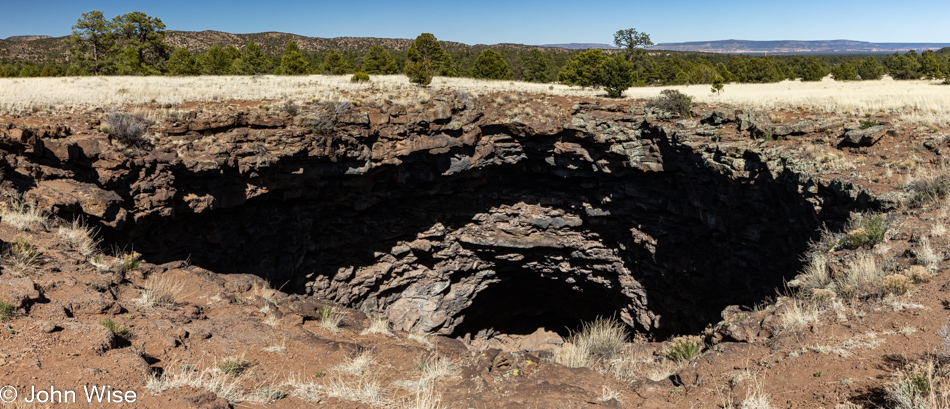
In trying to bring more detail to these posts, I often spend no small amount of time researching something or other about a particular location, in this instance, our next trail called El Calderon. I’m expecting somebody’s name, or maybe the word is related to the caldera, but what was nearly at the top of the list was the urban dictionary definition that brought a nice chuckle to my inner-14-year-old immature self; it reads: noun 1. A large, cavernous asshole similar to the caldera in a volcano; a hot, steamy, wide vagina. Example: Diarrhea erupted out of Erick’s Calderon like hot magma out of a volcano. Yep, I can see that in my photo.
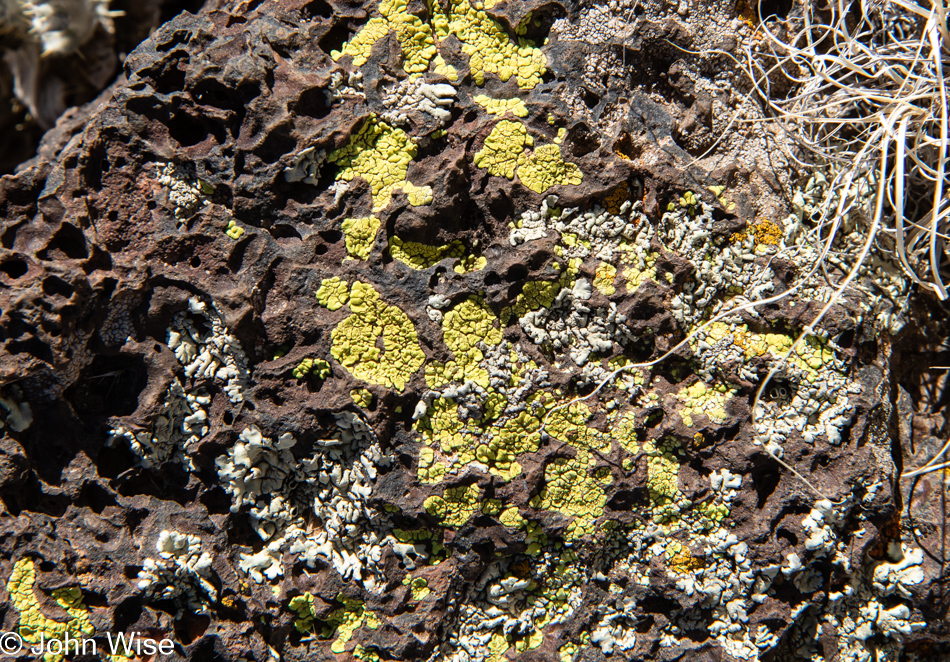
Well, this is an uncomfortable transition as I’m not able to muster an idea of how I go from the previous subject reference to talking about the beauty of lichen. I just searched the 2,870 published blog posts I’ve written over the years and see that I’ve written about lichen some 30 other times. I’m not going to take the time right now to read those posts as though I might discover some essence of lichen I’ve not yet shared. As a matter of fact, I hope that someone reading this might call me out for grasping at nothing to cover that I have nothing to say about this lichen growing on volcanic scoria rock.
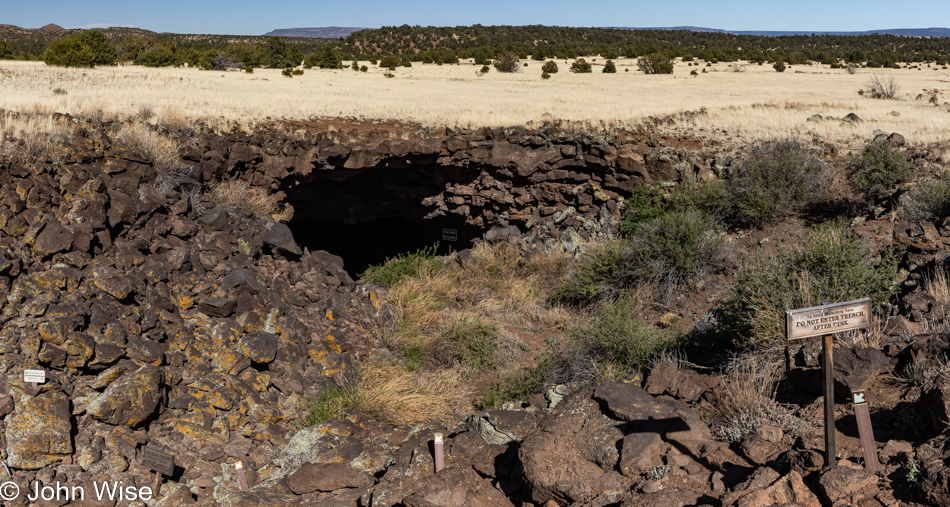
The lava tubes are off-limits here during our visit; seems that they might be forever off-limits. In the case of the bat cave, which is the hole straight ahead, due to a host of human impacts on the colony, we are no longer welcome lest we extinct them. To the left of this image in the same depression is the Xenolith cave, which requires a permit to visit, though I think those are currently not available.
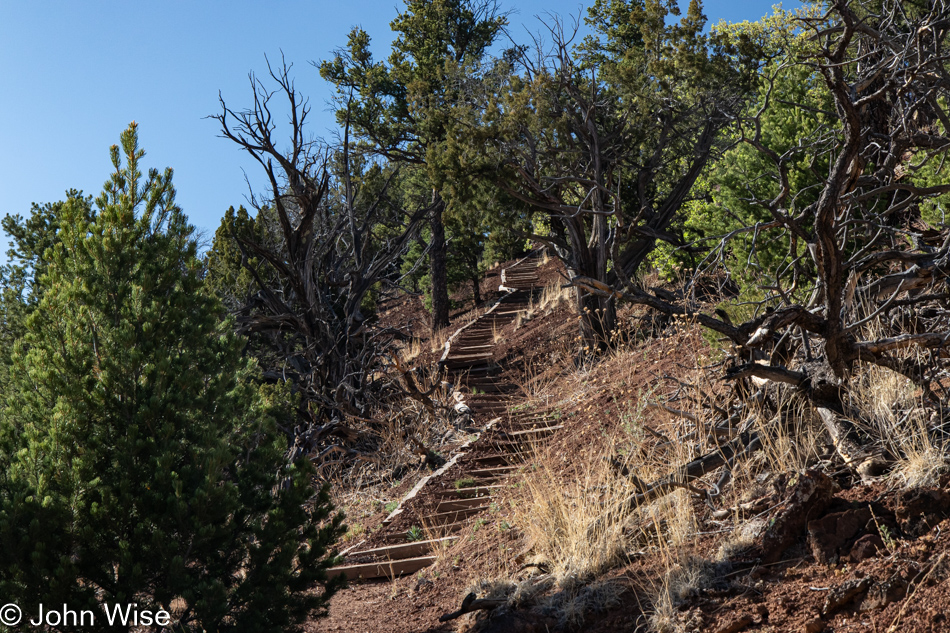
We’ve entered the El Calderon cinder cone, and while there’s a certain cool factor, there’s also an accompanying pucker factor. Sure, these loose cinders have been relatively stable for 115,000 years by now, but how does one ever really know when the steep slopes of a volcanic cone might crumble in a landslide, dragging trees, cinders, and John to the bottom of the cone?
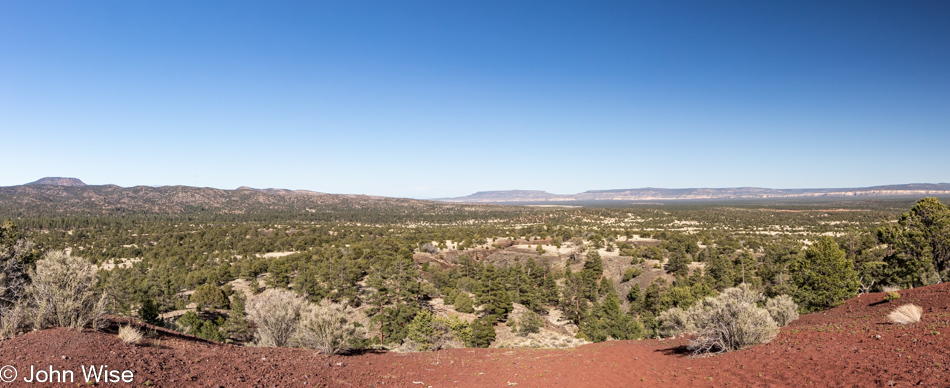
Frightened as I was, walking on millions of tiny hard rocks that seemed to shift with every step, I made it up to the rim trail.
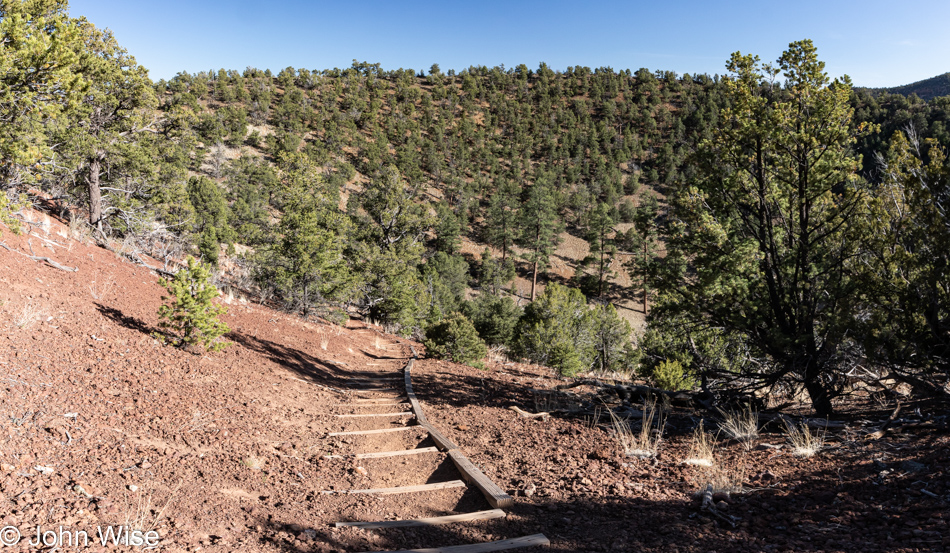
Looking out over the cone rim, I quickly ascertained that nature would be intent on taking my life today if I dared venture out upon the edge. I was freaking out as it was, walking on cinders contained by these meager pieces of wood that offered me little in the sense of personal security. I could see across the way an invitation to join the abyss as I was certain to slip on my fear.

Oh yeah, flat land. Not only was this path going to bring us back to the parking lot, but it would also allow us bragging rights about that day we were out on the Continental Divide Trail; who cares that it would only be one mile of the 3,100 mile total?
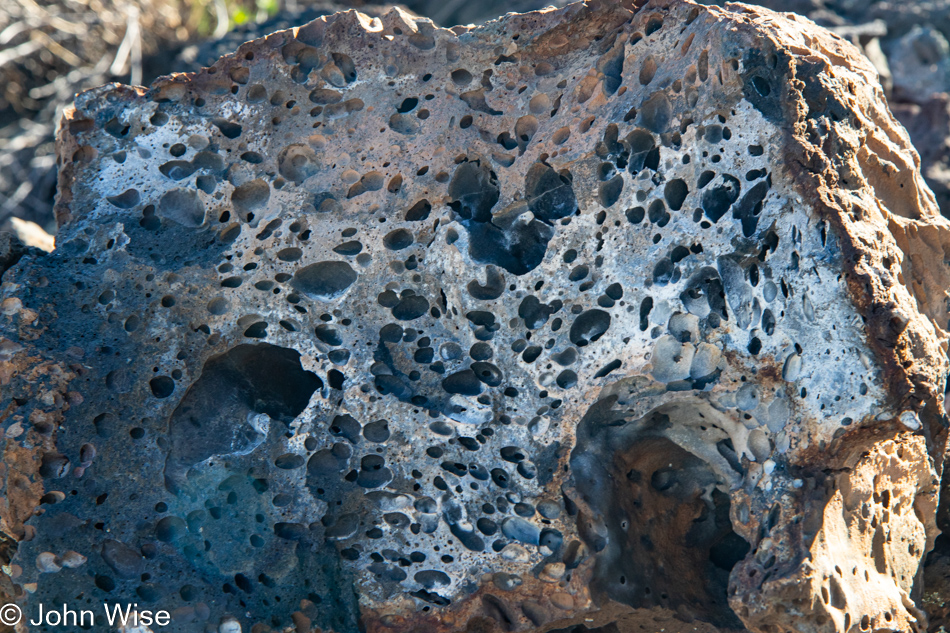
As ejecta leave the comfort of the netherworld and come to fly through the air or flow upon the surface of Earth, the escaping gases leave these holes, and it is this kind of volcanic rock I was referencing when I wrote of lichen growing upon scoria, a few photos above.

We’ve been out here among the trees and volcanic debris, falling in love with how beautiful it all is, how isolated we feel as there’s nobody else on the 5.6-mile trail with us, and how lucky we are to even want to be in these types of places. And though we are approaching 1o miles and our feet are tiring, we really don’t want the trail to end.
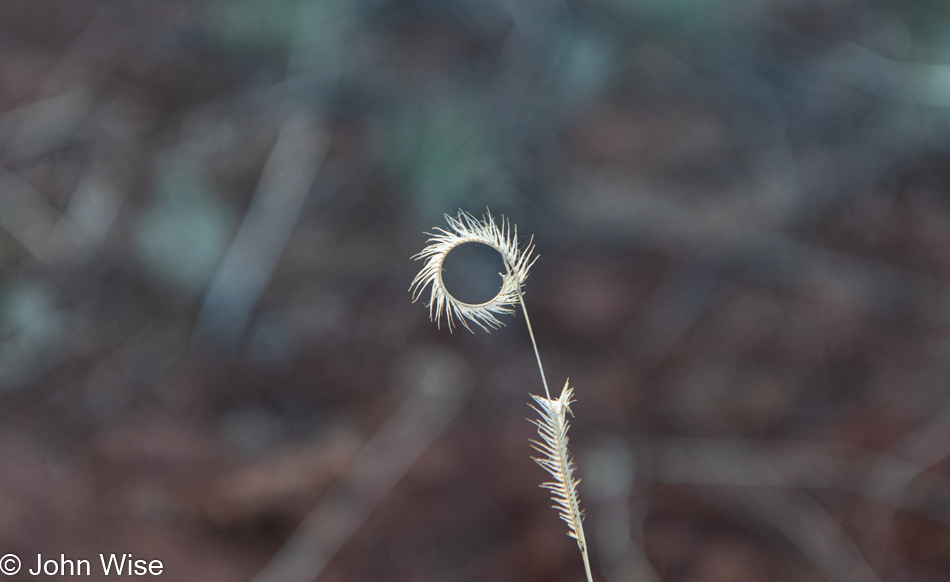
Going into this, we had no idea that New Mexico had an official state grass, but it turns out that this Blue Grama is, in fact, the grass that holds that distinction.

Should we jump on it or crawl under it? Caroline wanted nothing to do with either idea, well, neither did I…until I saw that on the left side, there was a hole that would make for an interesting framing of her face if she got up in there. Still a big nope. Was it the chance of snakes being under there or that I might walk over the volcano bridge trying to scare her that she stayed away?
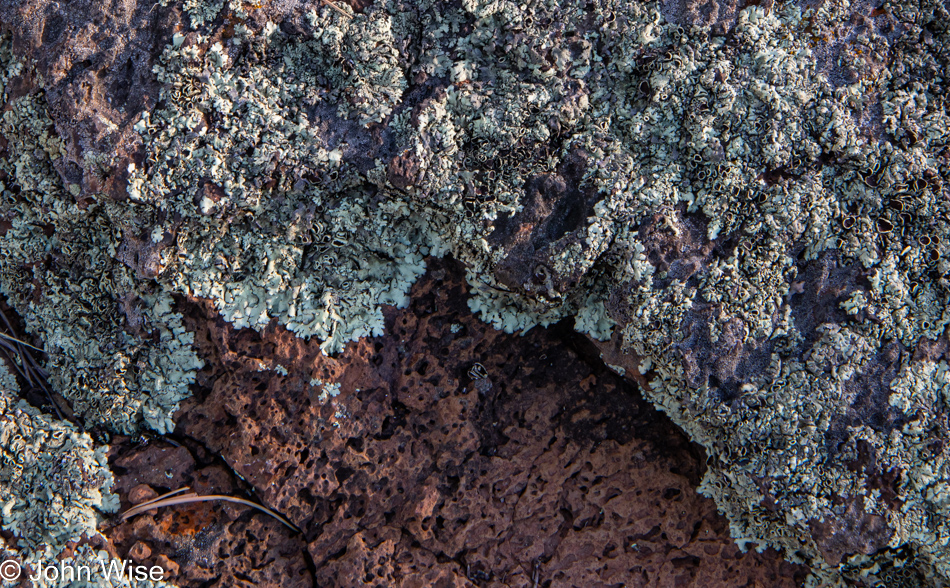
Oooh, am I looking at filaments of fungi colonized by cyanobacteria? You betchya. While the species looking at this lichen (me, the human) has been walking the earth for about 2 million years, and this particular example of its creatures will likely only be here for about 80 years, there are lichens on our planet that have been dated to 8,600 years old. The descendants of this composite organism have existed for between 250 – 480 million years with some controversial research suggesting that forms of lichen might have existed over 2 billion years ago. Not that this stuff really matters, but in some sense, this is like time travel, where, right before our faces, we are able to look into the proverbial faces of a living thing that predates everything else around us.
And then totally unrelated (unless you are interested in the appearance of life on this planet), but one of those facts (unless you are a fundamentalist) that piques my sense of aha-ness is how, while looking at the lichen, I consider what my wife shared with me last week. She said, “Isn’t it strange to think that sharks have been swimming in the ocean since before there were trees?” There’s a species that survived planetary cataclysm, extinctions including that of the dinosaurs, and ice ages, but it might not survive us because humans hate sharks and would rather eat or kill them instead of allowing them to coexist. Oh, you want to remind me that we are doing the same with wolves and bears? For the sake of life here on earth, lichen can consider itself lucky that we’ve not figured out how to make bullets small enough to wipe it out.
Maybe my point is that while we are allowed to fall into the magnificence of nature, it seems we are just as happy to have our eyes glued to television screens, our minds stuck on the shenanigans and crimes of celebrity and politics, and our souls bound to the lies we tell each other for the cause of making money and busy work so we don’t explore deeper questions of existence. So what is smarter, lichen or the two-legged idiots that would burn the planet to a crisp if it made madmen richer and eternally famous?
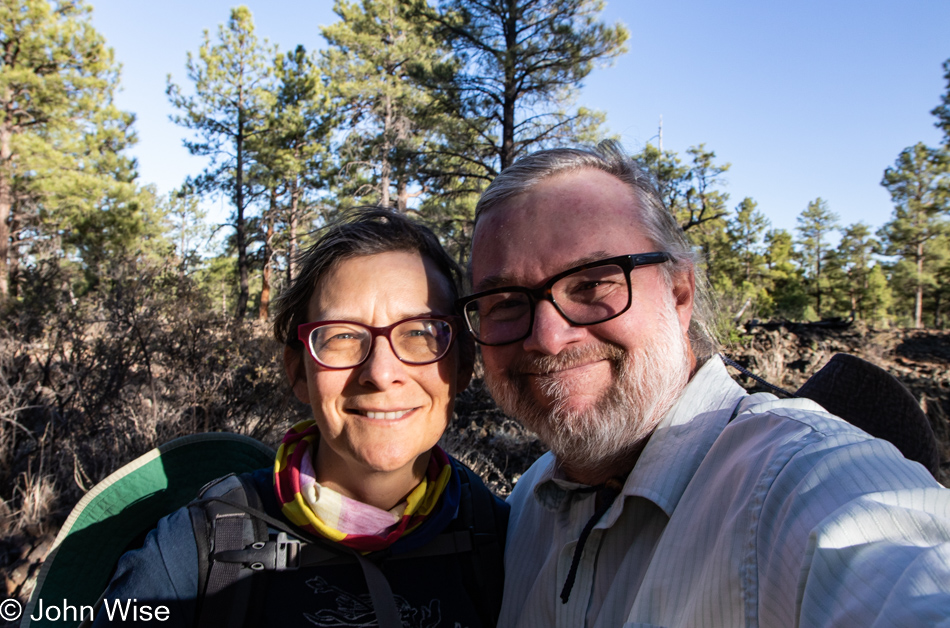
Jeez, what am I thinking when all I really want to do is finish this post so I can move further down the metaphorical trail here days after we left the literal trail called El Calderon? As I typed the last period after three paragraphs and 385 words above, which are just a small part of the over 4,500 words of this post that will never be read, I have to wonder why I didn’t just break it up to fill the spaces below. There’s an easy answer here that goes like this: writing allows me to linger in the experience of walking in the infinity of potential enjoyed beyond the confines of time and space we typically live in while in the routine of life. Out here, everything is blooming, happening, sparkling, and emerging before our senses. So the longer I dwell here with the images cementing memories of what might have otherwise passed, I’m still hiking in the woods with the smiling-faced human seen here in this photo among the lichen, trees, bugs, scoria, blue grama, and a trillion other things we missed.
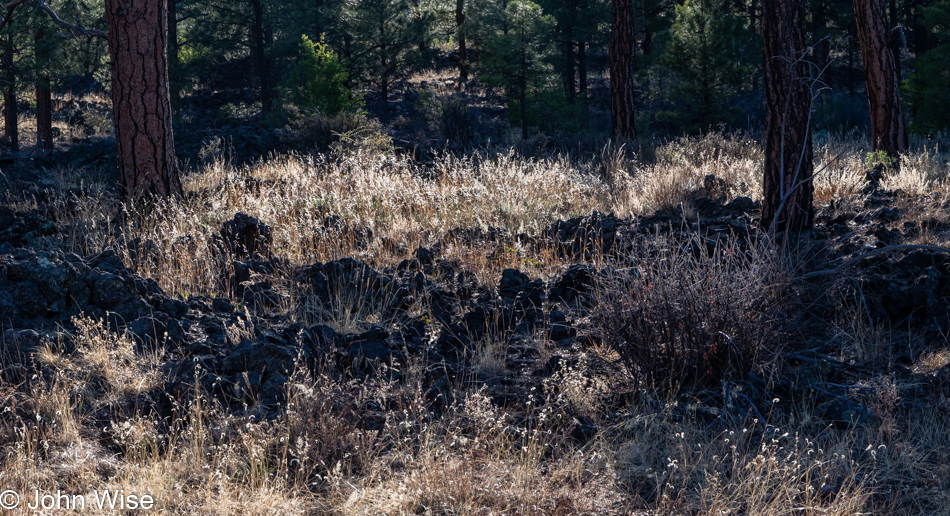
I’m starting to see a trend with these travel blog posts, specifically, Saturdays, where I pen this monumental screed that is likely quite duplicative of what preceded it. Don’t worry, though; I won’t give up writing about each and every trip we take this year, regardless of how repetitive I might be. I’m not too worried that I’ll write verbatim what’s been written before, but what choice do I have other than plagiarizing myself? Hmmm, I’m not cutting and pasting elements from those previous missives, so technically, I’m not really plagiarizing myself, but is there a word for being so thematically similar that it might sound like I’ve said it all before? Not to be indignant but even if I were redundant, who f’ing cares? I will forever know things about my life shared with Caroline that will remain vibrantly alive in our shadow years, where the glow of memories will be inching ever closer to darkness and my ultimate demise. The sun may be setting, but our enthusiasm to set out on yet another trail is not diminishing, and my desire to capture some tiny intrinsic part of what made a day special is still running full steam ahead.
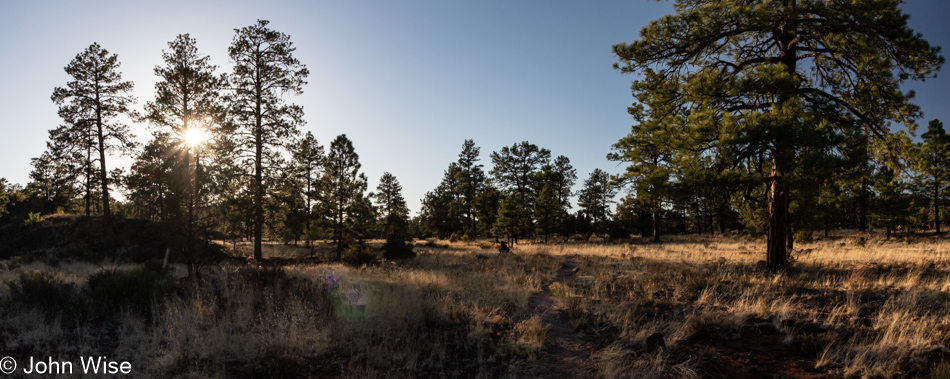
And so I write, trying to catch those elusive rays that illuminate not just the day but our continuing appreciation of the world and each other. This is all nothing more than the next installment in the saga of love, love of nature, love of sound, scent, hands, smiles, and the most tender moments found when love appears as golden as what lies ahead on the horizon of where we are yet to travel.
